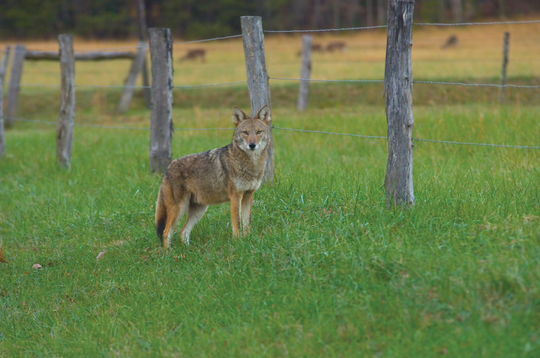Living With the Land

Improving human-wildlife coexistence in the Beaver Hills Biosphere.
The Beaver Hills is well-known for the diverse wildlife that live within the region. Up to 48 mammals, 152 birds and 8 amphibians and reptiles have been reported in this distinct landscape. In addition, more than 13,000 people reside within the Biosphere. Seasonally, there are more than 365,000 visitors to the region.
This means that, across the Biosphere, humans and wildlife must live alongside one another. For everyone to get along, residents and visitors alike must understand that to ‘live’ with wildlife means to coexist with wildlife in an ethical, sustainable way. It can be hard to know where to begin, though. It starts with understanding what species call the Biosphere home. Learning what they need. And learning how we can all be responsible stewards of this special place people and wildlife call home.
The Beaver Hills Biosphere’s Living With Wildlife initiative aims to fill some of the gaps in the public’s knowledge of this issue and build understanding of what it really means to ‘live with wildlife.’
“The focus is really living with the land, not on the land,” says Brian Ilnicki, the Biosphere's executive director.
Collecting data over the last couple years and consulting with experts and the public, the Biosphere has developed a plan to engage and educate the public on this vital issue. Engaging with different levels of government, Indigenous organizations and other NGOs, the Biosphere identified key species in the region and information on the human-wildlife interactions that take place, and created an outreach and communications plan to promote specific ways we can all live more effectively with these non-human residents.
Those communications will include a page on the Biosphere website that will serve as a source of human-wildlife coexistence information and recommendations, connecting folks with the information they need to act as ethical stewards of the land and co-inhabitants with wildlife.
The initiative will also include promotional postcards and stickers featuring the identified key species, including black bears, beavers, coyotes, wolves, cougars, elk and garter snakes. The campaign’s main call to action will be the Living With Wildlife pledge that will encourage people to respect and protect the land, animals and people of the Biosphere.
“The Biosphere’s mandate isn’t wildlife management. Our role is to make people aware of wildlife and integrate with the good work that other agencies are doing,” says Brian. “The BHB is a connector, collating the work others are doing, and connecting residents and visitors to those resources.”
For example, garter snakes have been a major focus of Strathcona County's own wildlife coexistence efforts. In collaboration with the Biosphere and other partners in the area, garter snakes were identified as particularly at risk from human activity.
Snakes often sun on the roads around Strathcona County. During the spring and summer, as they migrate to hibernacula, they’re at risk of being hit by cars. Partnering with the Biosphere and Friends of Elk Island, Strathcona County looked at garter snake collisions and devised a strategy to raise awareness of areas where snakes cross. Strathcona County installed signs along Range Road 210, where garter snakes were at particular risk, cautioning drivers to slow down and watch for snakes.
While deer or moose wildlife crossing signs are familiar sights to most drivers, the snake wildlife crossing signs might be new. But, as Matt Wood, Senior Wildlife Specialist with Strathcona County says, more than signs are needed. Snakes have faced bad PR over the years, and improving wildlife coexistence also needs to include a public narrative shift for these valuable but misunderstood creatures.
“Garter snakes aren’t a threat to people at all, they aren’t venomous. They eat mice, they do all kinds of good stuff,” explains Matt. “In the past, bats were seen in a negative light, and I think they've had a PR glow up. I think snakes need that same change in public perception.”
Ultimately, Matt says, the goal is to foster a sense of respect for all life forms. By educating the public about garter snake’s role, and helping people identify them more easily (and not confuse them for other snake species) will begin to shift these perceptions.
The Living With Wildlife initiative is just getting started. Working across different organizations, from municipalities to parks to environmental organizations, the Biosphere hopes to maximize the impact of the program. As the initiative grows and evolves, the Biosphere will host workshops for landowners to offer practical strategies to live with wildlife more effectively.
Human wildlife coexistence connects to every part of the Biosphere's mission. By bringing together stewardship, Indigenous knowledge, culture and sustainable development, we can ensure that humans and wildlife continue to flourish in the Biosphere.
I saw a live garter snake on range road 210 on April 27. About 1.5 ft. It was around the north entrance to calabo estates. The "watch for snakes" sign on range road 210 has disappeared again.
Comments